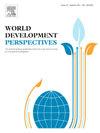当关闭失败时:揭露尼日利亚西南部废弃矿场的黄金再洗对环境的影响
IF 2.3
Q2 DEVELOPMENT STUDIES
引用次数: 0
摘要
黄金“洗矿者”是一群非法矿工,他们潜入封闭的冲积金矿,挖出并洗掉大块的泥,希望能提取出现场残留的金矿。本文探讨了这些矿工的再洗作业对环境的影响。为此,从进行作业的选定地点收集了土壤和水样。然后对样品进行物理化学分析,以确定操作造成的污染程度。对于土壤样本,在距离洗涤地点约50米的地方收集普通(对照)样本,同时也收集洗涤后的土壤样本,以检查操作对土壤样本的影响。与调查的所有地点的普通土壤相比,水洗土壤中氰化物和某些重金属(铬和铅)的存在显著增加。水洗土壤中的氰化物浓度(mg/kg)在所有站点都明显高于普通土壤:站点1(从0.7533到1.1160)、站点2(从0.7033到1.5188)、站点3(从1.0363到2.0000)。各站点采集的两种土壤样品水洗土壤与普通土壤的铬(mg/kg)浓度水平差异为站点1 (+0.29/+0.1305);Site 2 (+1.321/+0.891);站点3(+1.617/+1.541)和站点1(+0.229/+0.1645)的Pb (mg/kg);站点2 (+0.7505/+0.7065);站点3(+0.7315/+0.696)。与普通土壤相比,洗后土壤的平均pH值普遍下降:站点1(从6.150降至5.885);站点2(从6.455到5.518);地点3(土壤从5.890到5.010)。这种减少表明土壤酸度增加,可能是由于洗涤过程中碱性矿物质的浸出。水测试的结果还显示,有潜在健康风险和生态压力的地点的水样浊度升高。同样,水样显示低水平的溶解氧(DO),对水生生物有潜在的压力。通过与矿工的访谈和对采矿方法的直接观察,还从现场收集了定性数据,以确定作业如何对环境构成危险。从这些事件中吸取了教训,以便审查地雷规划者如何通过有效地规划关闭和复垦地雷来更好地保护环境。这篇论文还证明了有效的正规化努力的必要性,这种努力抓住了在这一职业中接受援助的贫困当地人的需求。本文章由计算机程序翻译,如有差异,请以英文原文为准。
When closure fails: Uncovering the environmental impact of gold rewashing on abandoned mine sites in Southwestern Nigeria
Gold “Rewashers” are groups of illegal miners who infiltrate closed alluvial gold mine sites to scoop out and wash chunks of mud with the hope of extracting any residual gold deposits in the site. This paper examines the implications of the rewashing operations by these miners on the environment. To achieve this, soil and water samples were collected from selected sites where the operations were being conducted. Physicochemical analyses were then conducted on the samples to determine the level of contamination from the operations. For the soil samples, ordinary (control) samples were collected about 50 m away from the washing sites while samples of the washed soil were also collected to examine the impact of the operations on the soil samples. There is a significant increase of the presence of cyanide and some heavy metals (Cr and Pb) in the washed soils compared with the ordinary soils across all sites investigated. The concentrations of cyanide (mg/kg) in washed soils are significantly higher than in ordinary soils across all sites: site 1 (from 0.7533 to 1.1160), site 2 (from 0.7033 to 1.5188), site 3 (from 1.0363 to 2.0000). The difference in concentration levels between washed and ordinary soils for the two soil samples collected in each site for Cr (mg/kg) are Site 1 (+0.29/+0.1305); Site 2 (+1.321/+0.891); Site 3 (+1.617/+1.541) and for Pb (mg/kg) Site 1 (+0.229/+0.1645); Site 2 (+0.7505/+0.7065); Site 3 (+0.7315/+0.696). There was a general drop in the average pH values of the washed soils as compared with the ordinary soils across all sites: site 1 (from 6.150 to 5.885); site 2 (from 6.455 to 5.518); and at site 3 (from 5.890 soil to 5.010). Such reductions suggest increased soil acidity, potentially due to the leaching of alkaline minerals during the washing process. The findings of the water tests also revealed elevated turbidity in the water samples from the sites with potential health risks and ecological stress. Similarly, the water samples show low level of dissolved oxygen (DO) with potential stress on aquatic life. Qualitative data were also collected from the sites through interviews conducted with the miners and direct observation of the mining methods to identify how the operations pose danger to the environment. Lessons were drawn from these occurrences to examine how mine planners can better protect the environment by efficiently planning for mine closure and reclamation. The paper also justifies the need for effective formalisation effort that capture the needs of the impoverished locals who take succor in this occupation.
求助全文
通过发布文献求助,成功后即可免费获取论文全文。
去求助
来源期刊

World Development Perspectives
Social Sciences-Sociology and Political Science
CiteScore
4.50
自引率
0.00%
发文量
65
审稿时长
84 days
期刊介绍:
World Development Perspectives is a multi-disciplinary journal of international development. It seeks to explore ways of improving human well-being by examining the performance and impact of interventions designed to address issues related to: poverty alleviation, public health and malnutrition, agricultural production, natural resource governance, globalization and transnational processes, technological progress, gender and social discrimination, and participation in economic and political life. Above all, we are particularly interested in the role of historical, legal, social, economic, political, biophysical, and/or ecological contexts in shaping development processes and outcomes.
 求助内容:
求助内容: 应助结果提醒方式:
应助结果提醒方式:


